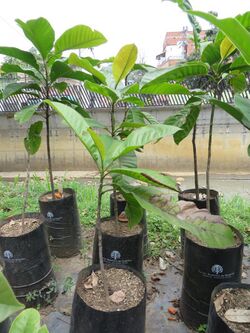Biology:Magnolia jardinensis
| Magnolia jardinensis | |
|---|---|

| |
| Scientific classification | |
| Kingdom: | Plantae |
| Clade: | Tracheophytes |
| Clade: | Angiosperms |
| Clade: | Magnoliids |
| Order: | Magnoliales |
| Family: | Magnoliaceae |
| Genus: | Magnolia |
| Section: | Magnolia sect. Talauma |
| Species: | M. jardinensis
|
| Binomial name | |
| Magnolia jardinensis M.Serna, C.Velásquez & Cogollo
| |
Magnolia jardinensis is a tree native to Colombia and endangered due to its exploitation. Common names include Gallinazo blanco, copachí and centello.
Description
This tree can reach a height of up to 25 m and up to 60 cm in diameter. The bark is grey coloured with dark streaks. Young leaves have a woolly and golden pubescence. Leaves are spiralled, elliptic and chartaceous, 15.3 cm to 34 cm in length and 10.6 to 21.4 cm in width. They have a dense, golden pubescence on the underside, with a petiole streaked longitudinally. Flowers are cream-coloured, with a floral bud with three pubescent bracts, three sepals and eight pulpy petals. Fruits are small and elliptical.[2][3][4]
Distribution and habitat
The tree is endemic to the Colombian department of Antioquia. It grows in tropical forest and in very wet low mountain forest, in the western cordillera of Jardín, between 1,900 and 2,800m altitude.[4]
Uses
In the past it was probably a very sought-after logged timber species, similar to others species of its family.[4]
Conservation status
Magnolia jardinensis was classified as a critically endangered species (CR) by the Red book of Colombian plants,[5] which is due to its distributional range and because the population is very small.[4]
Flowering and fruiting
The tree has flowers almost the whole year, with a slight decrease of the reproductive output during the month of June. It offers an abundant flowering with floral buds and opened flowers covering more than 20% of the top. Insects pollinate the flowers. The production of fruits is low, which is due to numerous miscarriages during this process. During the rainy season (December to February and August to September) the production of fruits increases.[6] Seeds are scattered by birds and small mammals.[4]
References
- ↑ Calderon, E.; Cogollo, A.; Rivers, M.C.; Serna-Gonzalez, M. (2016). "Magnolia jardinensis". IUCN Red List of Threatened Species 2016: e.T14050337A67514058. doi:10.2305/IUCN.UK.2016-1.RLTS.T14050337A67514058.en. https://www.iucnredlist.org/species/14050337/67514058. Retrieved 20 November 2021.
- ↑ Velásquez R., C. y Serna G., M. 2005. Magnoliáceas de Antioquia. Jardín Botánico Joaquín Antonio Uribe - CORANTIOQUIA - OIMT. Primera Edición. Medellín, Colombia. 32 p.
- ↑ Serna G., M.; Velásquez R., C. A. y Cogollo P., A. 2009. Novedades taxonómicas y un nuevo registro de Magnoliaceae para Colombia. The New York Botanical Garden Press, Bronx, NY. Brittonia, 61(1), 2009. 35-40.
- ↑ 4.0 4.1 4.2 4.3 4.4 Trujillo, L.; Agudelo, G.; Restrepo, M.; Cardona, E.; Murillo, J..Avances en la estrategia para la conservación de las especies de las familia Magnoliaceae en Jurisdición de CORANTIOQUIA, Medellín: CORANTIOQUIA, 2011 100.p. (Boletín Técnico Biodiversidad; No. 6, Diciembre 2011)
- ↑ Calderón S., E.; A. Cogollo P; C. Velásquez R.; M. Serna G. y N. García.2007. Las magnoliáceas. Pp. 45-154. En: García, N. (ed.). Libro Rojo de Plantas de Colombia. Volumen 5: Las magnoliáceas, las miristicáceas y las podocarpáceas. Serie Libros Rojos de Especies Amenazadas de Colombia. Bogotá, Colombia. Instituto Alexander von Humboldt - CORANTIOQUIA - Jardín Botánico Joaquín Antonio Uribe- Instituto de Ciencias Naturales de la Universidad Nacional de Colombia - Ministerio de Ambiente, Vivienda y Desarrollo Territorial. 236 p.
- ↑ Con base en los informes de trabajo de campo de Suárez, G.A., 2001-2008.
External links
- Botanical Garden of Medellín, and its scientific Director Alvaro Cogollo, leading Magnolia conservation science in Antioquia department.
- South Pole Carbon, company leading a Magnolia conservation programme in Antioquia with the help of carbon finance.
Wikidata ☰ Q16662022 entry
 |



